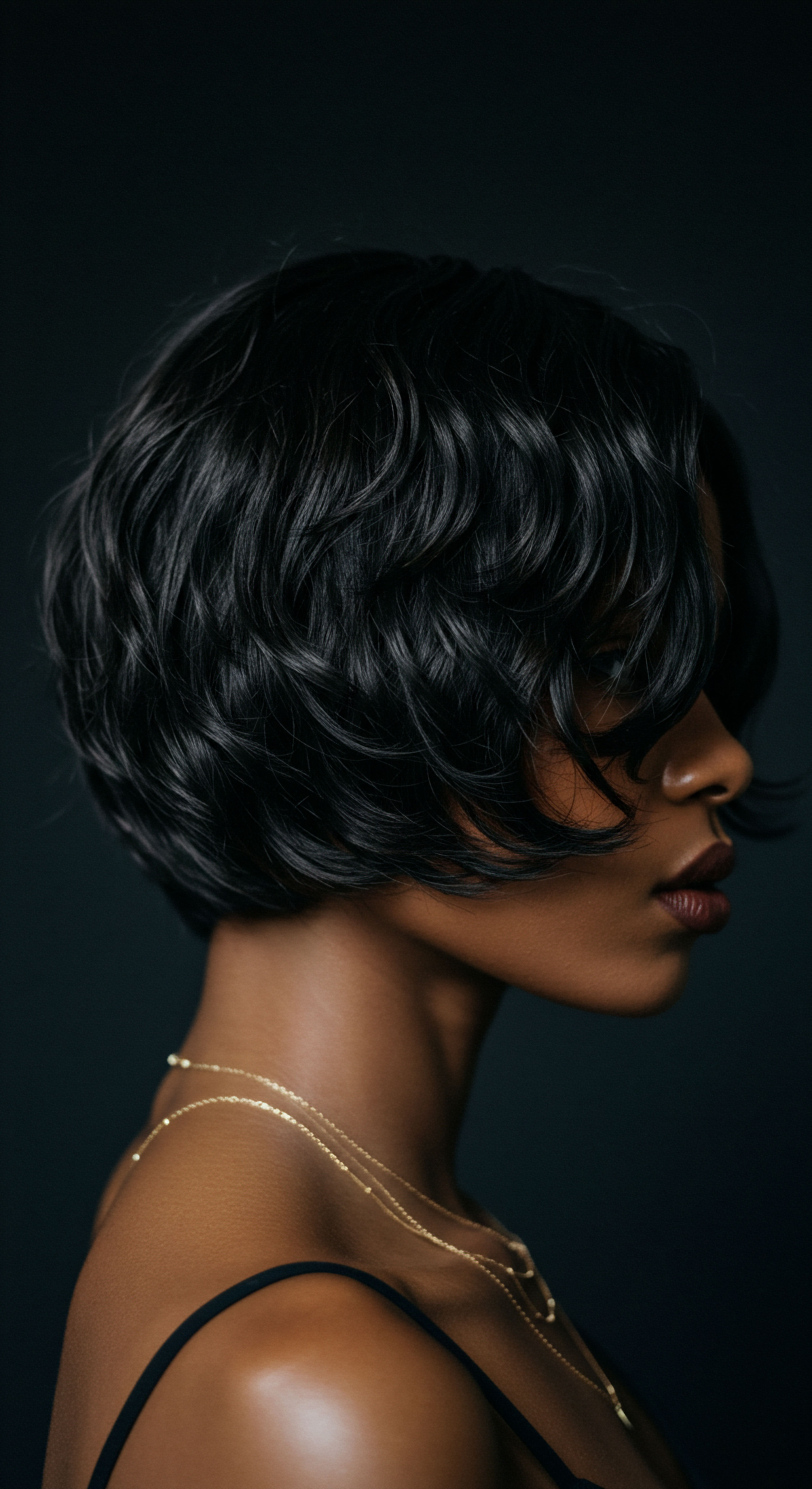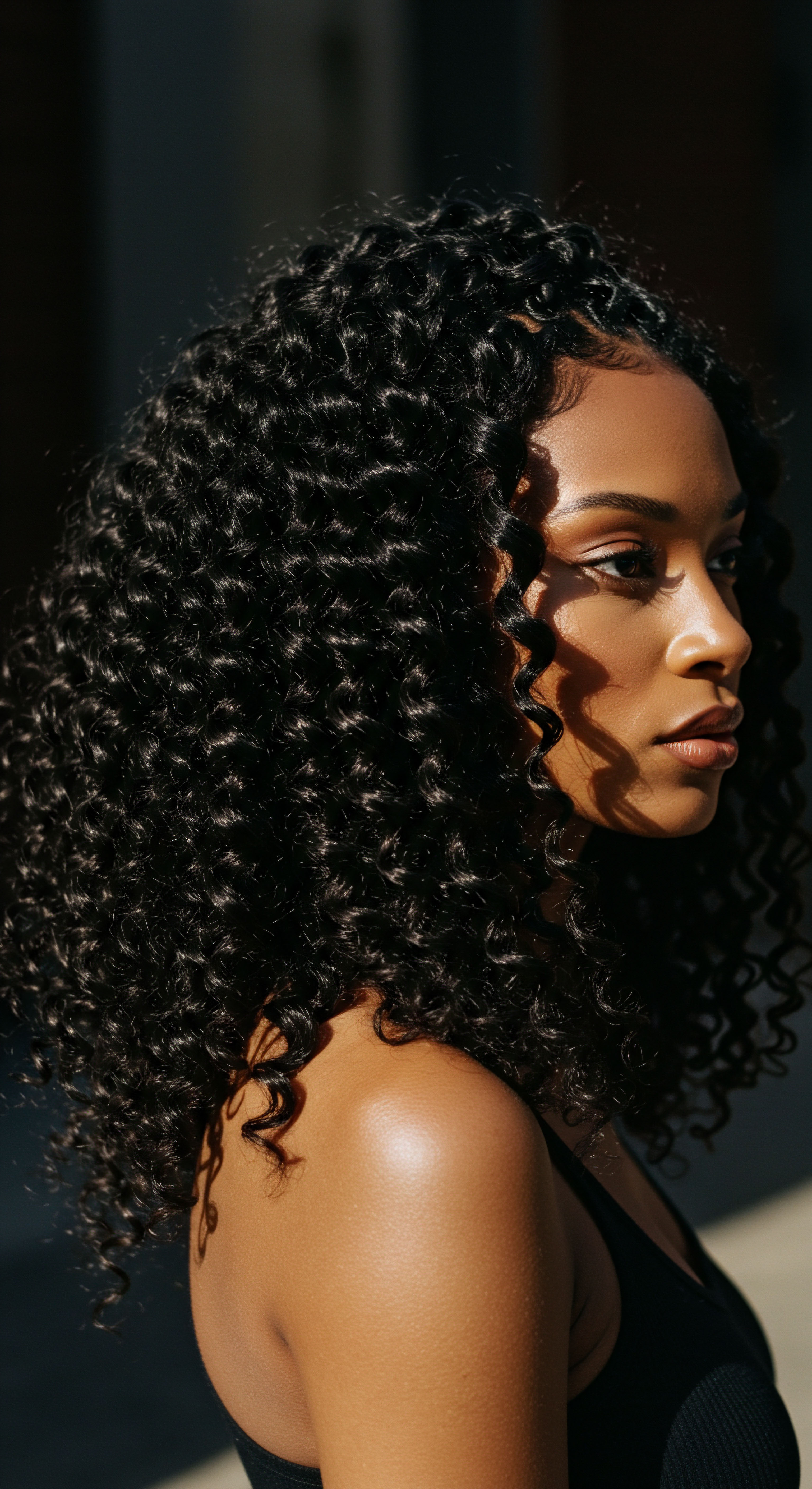
Roots
The whisper of ancient winds carries stories of care, of connection to the earth, and of beauty rituals that long predate our bottled concoctions. For those of us with textured hair, a gentle curiosity often stirs ❉ how did our ancestors, without the aisles of conditioners and specialized shampoos, maintain their crowning glory? This quiet questioning leads us to the very beginnings of hair cleansing, a practice not born of a chemist’s lab, but from the generous embrace of the natural world. It invites us to consider a time when every leaf, every root, every grain of earth held a potential secret for well-being.

What Did Early Cultures Use for Hair Cleansing
Across continents and epochs, early civilizations turned to what was readily available, discerning the properties of plants, minerals, and even animal products for hygiene. The earliest forms of cleansing agents were often simple, yet remarkably effective, drawing upon the inherent qualities of nature.
- Plant-Based Saponins ❉ Many cultures discovered plants containing saponins, natural compounds that produce a soap-like lather when mixed with water. These plants, such as soapnuts (Sapindus mukorossi, also known as reetha or aritha), shikakai (Acacia concinna), and soapwort (Saponaria officinalis), were central to ancient hair cleansing rituals. When boiled or steeped, these botanical wonders would release their cleansing agents, offering a gentle yet effective wash that did not strip hair of its natural oils. In India, for instance, the use of saponiferous fruits for hair cleansing dates back to pre-Harappan civilization, underscoring a long history of hygienic customs.
- Clays and Earths ❉ Mineral-rich clays, like rhassoul clay from Morocco or bentonite clay, served as powerful purifiers. These clays possess adsorbent properties, drawing out impurities, excess oil, and environmental pollutants from the scalp and hair. They could be mixed with water to form a paste, providing a detoxifying wash that left hair feeling refreshed and clean without harshness. In places like Iran, bentonite clay has been widely used as a hair cleanser since old times.
- Alkaline Substances ❉ Before refined soap, some cultures utilized ash from wood fires. When mixed with water, wood ash creates lye, an alkaline solution. While potentially harsh if not carefully prepared, this rudimentary soap was used for various washing purposes, including hair, particularly in regions where other cleansing agents were scarce. The Vikings, for example, reportedly used a strong soap made from animal fats, ash, and lye, which also had the effect of lightening hair to a desirable blond.
- Acidic Rinses ❉ Counteracting the effects of hard water or alkaline washes, acidic rinses were also employed. Citrus juices, vinegar, and fermented grains like rice water provided a conditioning and clarifying effect, helping to balance the hair’s pH and impart shine. Chinese women, known for their long, dark hair, traditionally used rice water rinses to maintain luster and strength.

The Hair’s Intrinsic Needs
Understanding how early cultures cleansed hair begins with acknowledging the fundamental needs of hair itself. Hair, particularly textured hair, possesses a unique structure that requires both cleansing and care to thrive. Early cultures intuitively grasped this balance, even without the scientific language we possess today.
They sought ingredients that could remove dirt and oil without excessively dehydrating the strands, preserving the hair’s natural moisture and integrity. The very concept of “cleansing” was less about stripping and more about a gentle restoration, a dance between purification and preservation.
Early hair cleansing was a careful balance, utilizing natural elements to purify without depleting the hair’s inherent vitality.
The practices of antiquity remind us that hair care is not merely about external appearance, but a deeper connection to well-being and the gifts of the earth. These foundational approaches set the stage for the elaborate rituals that would follow, shaping a legacy of natural hair care that continues to resonate today.

Ritual
Stepping beyond the simple gathering of ingredients, we arrive at the heart of ancient hair care ❉ the ritual. These were not quick, utilitarian acts, but often thoughtful, deliberate processes, interwoven with daily life, cultural significance, and a profound respect for the body and its connection to the environment. The act of cleansing hair became a moment of presence, a gentle communion with the self and with nature’s offerings.

The Methods of Application
The application of these natural cleansers varied widely, reflecting local resources, climate, and cultural customs. From simple washes to more elaborate preparations, each method aimed to maximize the efficacy of the chosen ingredients while honoring the hair’s unique qualities.
- Infusions and Decoctions ❉ Many plant-based cleansers were prepared as infusions or decoctions. This involved steeping or boiling herbs, barks, or fruits in water to extract their beneficial compounds, particularly saponins. The resulting liquid would then be used to wash the hair. For example, in ancient India, soapberries (Sapindus) were boiled with dried Indian gooseberry (Amla) and other herbs, then strained to create an effective hair cleanser. This process allowed for a gentle lather that purified the hair without stripping its natural oils.
- Clay Pastes and Masks ❉ Clays were often mixed with water to form a smooth paste, which was then applied directly to the scalp and hair. This allowed the clay to absorb impurities and excess sebum. After a period, the paste would be rinsed away, leaving hair clean and refreshed. Rhassoul clay, for instance, from the Arabic word ‘ghassala’ meaning to wash, was used in North Africa as a mud wash that cleaned hair and scalp without stripping helpful properties.
- Ash Lye Washes ❉ In certain traditions, particularly where soap-making was nascent or natural saponins were scarce, wood ash lye was carefully prepared. The process involved leaching water through wood ashes to create an alkaline solution. This solution, often diluted, was then used to wash hair. The Vikings, for example, employed such a strong lye-based soap, which also offered the unintended benefit of lightening hair. The careful preparation of lye was crucial, as too strong a solution could be damaging to both skin and hair.

Tools and Techniques of Cleansing
Beyond the ingredients, the physical act of cleansing also relied on simple, yet effective tools and techniques. Hands were, of course, the primary instruments, working the natural cleansers through the strands and massaging the scalp.
Combs and Brushes made from natural materials like wood, bone, or ivory were used not only for styling but also for detangling and aiding in the distribution of cleansing agents. These tools facilitated the removal of debris and stimulated the scalp, promoting circulation. Ancient Egyptians, for instance, valued gentle handling, using such combs to detangle hair without causing damage, and scalp massages were a regular component of their hair care practices, believed to stimulate growth.
Ancient cleansing was not merely about hygiene; it was a sensory engagement, a connection to the natural world through touch and aroma.
The frequency of washing also varied. Unlike modern daily washing habits, many ancient cultures cleansed hair less frequently, perhaps due to the gentler nature of their cleansers or the scarcity of water. This allowed the hair’s natural oils to remain, contributing to overall hair health. The wisdom of these rituals, rooted in practicality and a deep understanding of nature, offers valuable lessons for contemporary hair care, particularly for those seeking gentler, more sustainable approaches.
| Cleansing Agent Shikakai |
| Primary Source Acacia concinna pods |
| Cultural Origin India, Southeast Asia |
| Cleansing Agent Soapnuts (Reetha) |
| Primary Source Sapindus mukorossi fruits |
| Cultural Origin India, China |
| Cleansing Agent Rhassoul Clay |
| Primary Source Mineral clay |
| Cultural Origin Morocco, North Africa |
| Cleansing Agent Yucca Root |
| Primary Source Yucca plant root |
| Cultural Origin Native American tribes |
| Cleansing Agent Wood Ash Lye |
| Primary Source Wood ashes |
| Cultural Origin Various, e.g. Vikings, Mesopotamia |
| Cleansing Agent These natural agents formed the foundation of ancient hair cleansing practices. |

Relay
The wisdom of early hair cleansing, passed down through generations, represents more than historical footnotes; it forms a profound scientific and cultural dialogue with our present understanding of hair health. To truly grasp how early cultures cleansed hair without modern products, we must peel back the layers of simple observation and reveal the underlying mechanisms at play, often supported by contemporary research. This journey takes us from the visible effects of natural ingredients to the subtle biochemical interactions that made them so effective.

The Science of Saponins and Their Action
Many ancient cleansers, particularly those derived from plants, owe their efficacy to compounds known as Saponins. These natural glycosides possess surfactant properties, meaning they can lower the surface tension of water, allowing it to mix more readily with oils and dirt. When agitated, saponins create a gentle lather, which then encapsulates oil and grime, making it easier to rinse away. This action is similar to synthetic surfactants found in modern shampoos, but with a crucial distinction.
Research highlights that natural surfactants, like those from Acacia Concinna (shikakai) and Sapindus Mukorossi (soapnuts), cleanse effectively by removing sebum and impurities. However, they typically produce less foam than their synthetic counterparts and are often milder, preserving the hair’s natural moisture balance. This gentleness is particularly significant for textured hair, which tends to be more prone to dryness due to its unique structure. The mild pH of shikakai, for example, is considered ideal for cleansing without stripping the hair’s natural oils.

Mineral Clays as Detoxifiers
Clays, such as bentonite and rhassoul, acted as natural detoxifiers and purifiers. Their cleansing ability stems from their unique molecular structure, which carries a negative electrical charge. This charge allows them to attract and bind to positively charged toxins, heavy metals, and impurities present on the hair and scalp, including product buildup and excess sebum. As the clay dries, it draws these unwanted elements away, and upon rinsing, they are carried away with the clay particles.
This physical adsorption mechanism provides a deep cleanse that is both effective and gentle, without harsh chemical interactions. The use of such clays speaks to an intuitive understanding of deep cleansing that went beyond mere surface washing.

The Role of Alkalinity and Acidity
The careful balance of pH was also a silent orchestrator in ancient hair care. While some early cleansers, like certain ash lye preparations, were alkaline, many cultures understood the need to balance this with acidic rinses. Hair and scalp maintain a slightly acidic pH, which helps to keep the cuticle smooth and closed, protecting the hair shaft and preventing moisture loss. Highly alkaline substances can lift the cuticle, leading to dryness and breakage.
This is why practices like rinsing with diluted vinegar or citrus juice, as seen in ancient Greek and Roman traditions, or rice water in East Asian cultures, were so important. These acidic rinses helped to restore the scalp’s natural pH, smooth the cuticle, and impart a healthy shine, a practice that aligns with modern understanding of hair science.

A Case Study in Cultural Hair Wisdom ❉ The Himba of Namibia
To illustrate the depth of cultural hair practices, consider the Himba people of Namibia. Their distinctive hair care ritual, known as Otjize Paste, provides a compelling example of ancient cleansing and conditioning that defies modern conventions. This mixture, made from butterfat and ochre pigment, serves as a cosmetic, a cleanser, and a protectant. Applied regularly, it cleanses the skin and hair over long periods, especially crucial in a water-scarce environment, and shields against the hot, dry climate.
While not a traditional “wash” in the Western sense, otjize functions as a dry cleansing method. The butterfat acts as a binder for dirt and impurities, which are then physically removed or absorbed by the ochre. The ochre also provides natural sun protection and imparts the Himba’s characteristic reddish-orange hair color, which carries deep cultural and aesthetic significance, symbolizing the earth’s rich red color and blood, the essence of life.
This practice challenges our preconceived notions of cleanliness, demonstrating how hair care can be deeply intertwined with environmental adaptation, cultural identity, and a holistic approach to well-being, rather than simply removing every trace of natural oil. The Himba’s practice highlights that “clean” can mean something far different from the lather-and-rinse cycle we commonly associate with hair care.
The Himba’s otjize paste reveals that hair cleansing can be a cultural statement, a protective shield, and a profound connection to the land, moving beyond mere hygiene.
This historical context underscores that ancient cultures were not simply stumbling upon effective methods; they were developing sophisticated systems of care that often mirrored, or even surpassed, aspects of our contemporary scientific understanding. The legacy of their natural cleansing practices provides a rich source of inspiration for modern textured hair care, advocating for gentleness, natural ingredients, and a deeper appreciation for hair’s inherent needs.

How Did Ancient Practices Impact Scalp Health?
The emphasis on natural ingredients and gentle methods in early cultures likely contributed to healthier scalp environments. Unlike many modern shampoos containing harsh sulfates that can strip the scalp’s natural protective barrier, traditional cleansers often worked in harmony with the scalp’s microbiome. For instance, many saponin-rich plants, such as Acacia Concinna and Camellia Oleifera, exhibit antimicrobial properties, helping to inhibit the growth of pathogenic microorganisms on the skin. This would have provided a natural defense against common scalp conditions like dandruff or fungal infections, without causing irritation or excessive dryness.
The consistent use of nourishing oils, often massaged into the scalp, further supported blood circulation and maintained a balanced, hydrated scalp, creating an optimal environment for hair growth. This holistic approach, treating the scalp as the foundation for healthy hair, is a wisdom that echoes through time.

Reflection
As we close this exploration into the ancient world of hair cleansing, a quiet understanding settles within us. The modern pursuit of hair wellness, particularly for textured strands, often feels like a complex maze of products and techniques. Yet, looking back, we see a simpler path, one paved with earth’s raw gifts and a profound, intuitive connection to nature. The wisdom of early cultures offers more than historical anecdotes; it provides a gentle mirror, inviting us to reconsider our own practices.
Perhaps the true secret our ancestors held was not a single miraculous ingredient, but rather a mindset ❉ a deep respect for the rhythms of the natural world and a recognition of hair as a living extension of our being. Their methods, born of necessity and observation, remind us that genuine care can arise from simplicity, from the inherent properties of a plant, the purity of clay, or the balance of an acid. For Roothea, this journey reinforces a central tenet ❉ that the most profound beauty rituals are those that honor our heritage, our unique hair, and the enduring generosity of the earth beneath our feet. The whispers of the past continue to guide us toward a more harmonious way of tending to our crowns.

References
- Ranganathan, L. & Ranganathan, P. (2023). Natural alternatives from your garden for hair care ❉ Revisiting the benefits of tropical herbs. Journal of Cosmetic Dermatology, 22(12), 3365-3376.
- Cosmetopoeia of African Plants in Hair Treatment and Care ❉ Topical Nutrition and the Antidiabetic Connection? (2024). Diversity, 16(2), 96.
- Lau, H. (2023). The Legacy of Lathers ❉ Tracing the Historical Use of Natural Ingredients in Hair Cleansing.
- Homan, P. G. (2019). Baldness ❉ A brief history of treatments, from antiquity to the present. Pharmaceutical Historian, 49(1), 24-30.
- Hussein, S. (2018). The role of the hair in ancient Egypt. International Journal of Tourism and Hospitality Management, 1(1), 77-83.
- Akram, M. et al. (2024). Hair Care Secrets of the Past ❉ What Our Ancestors Used for Healthy Hair.
- Kora, A. J. (2022). Plant saponin biosurfactants used as soap, hair cleanser and detergent in India. Journal of Surfactants and Detergents, 25(6), 1147-1159.
- SnappyDragon Studios. (2024). Medieval Hair Washing Myths Busted.
- Natureofthings. (n.d.). Getting To The Root of Hair Cleansing.
- Sellox Blog. (2021). Ancient African Hair Growth Secrets For Healthy Hair.
- The Past. (2025). The magic and power of hair in ancient Egypt.
- Joy Garden. (2024). Ancient Herbal Cleansing ❉ Natural Wisdom from China to the World.
- Ruwaa Life. (2024). Tresses Through Time ❉ A Journey Through the History of Hair Care.
- Helenatur. (2019). Herbal power for dry hair.
- Nowiamnappy’s. (2020). Top 5 Ayurvedic Herbs that Cleanse the Hair | Saponin Cleansing Herbs.
- ScienceIndiamag. (2025). Indian Beginnings of the Shampoo.
- Vogue Philippines. (2023). ‘Gugo,’ The Ancient Filipino Hair Care Ingredient.
- PFAF.org. (n.d.). Soap Plants saponins.
- Reddit. (2021). Homemade herbal cleansing water for clean, strong and shiny hair.
- HeyCurls. (2021). 6 Amazing Bentonite Clay Hair Benefits & How To Use It.
- Rthvi. (2024). Exploring Ancient Hair Care Rituals ❉ Timeless Practices for Modern Hair Wellness.
- A Brief History of Dry Shampoo ❉ from ancient Clays & Powders to Industrialized Aerosol. (2022).
- Moosavi, M. (2017). Bentonite Clay as a Natural Remedy ❉ A Brief Review. Iranian Journal of Public Health, 46(9), 1176–1183.
- Arab News. (2012). The secret of ancient Egyptian beauty.
- Realizations with Tiffany K. Charles. (2023). From Ancient Rituals to Modern Marvels ❉ A Journey through the History of Hair Washing, Shampoo, and Conditioner.
- Hong Kong Macao Traditional Chinese Medicine Research Institute. (n.d.). Chinese Herbal Shampoo.
- Lenz, P. (2024). A history of… shampoo.
- AYANAE. (2025). The History of Chebe Powder ❉ An Ancient African Hair Secret for Hair Growth.
- My Framer Site. (2024). The Art of Ayurvedic Hair Care ❉ 8 Tips for Stunning Locks.
- AYANAE. (2024). Powerful African and Asian Herbs for Hair Growth ❉ Nature’s Remedies fo.
- Middle East And North Africa. (n.d.). Ancient Mesopotamian Beauty, Hairstyles and Toilets.
- Hairstory. (2024). The History of Shampoo | Shampoo Origins and Evolution.
- Middle East And North Africa. (n.d.). Ancient Mesopotamian Beauty, Hairstyles and Toilets.
- Africa Imports. (n.d.). Traditional African Secrets For Long And Healthy Hair.
- Curl Maven. (n.d.). Step by Step Washday Routine for Afro Hair.
- Cosmetopoeia of African Plants in Hair Treatment and Care ❉ Topical Nutrition and the Antidiabetic Connection? (2024). Diversity, 16(2), 96.
- Quora. (n.d.). What did the Vikings use to wash their hair? – History of England.
- Living History. (2024). Golden Locks ❉ Hair Care in the Renaissance Era.
- Quora. (n.d.). In ancient times, what properties of wood ash make them suitable to be used as soaps?
- Reddit. (2021). No raw oils and butters vs. Traditional African hair care?
- Regirl. (2021). 7 Simple Ways To Wash Your Natural Hair Without Shampoo.
- City of David. (2024). Cleaning materials from ancient times.
- Oracc. (n.d.). The Nineveh Medical Project – Techniques of Mesopotamian medicine.